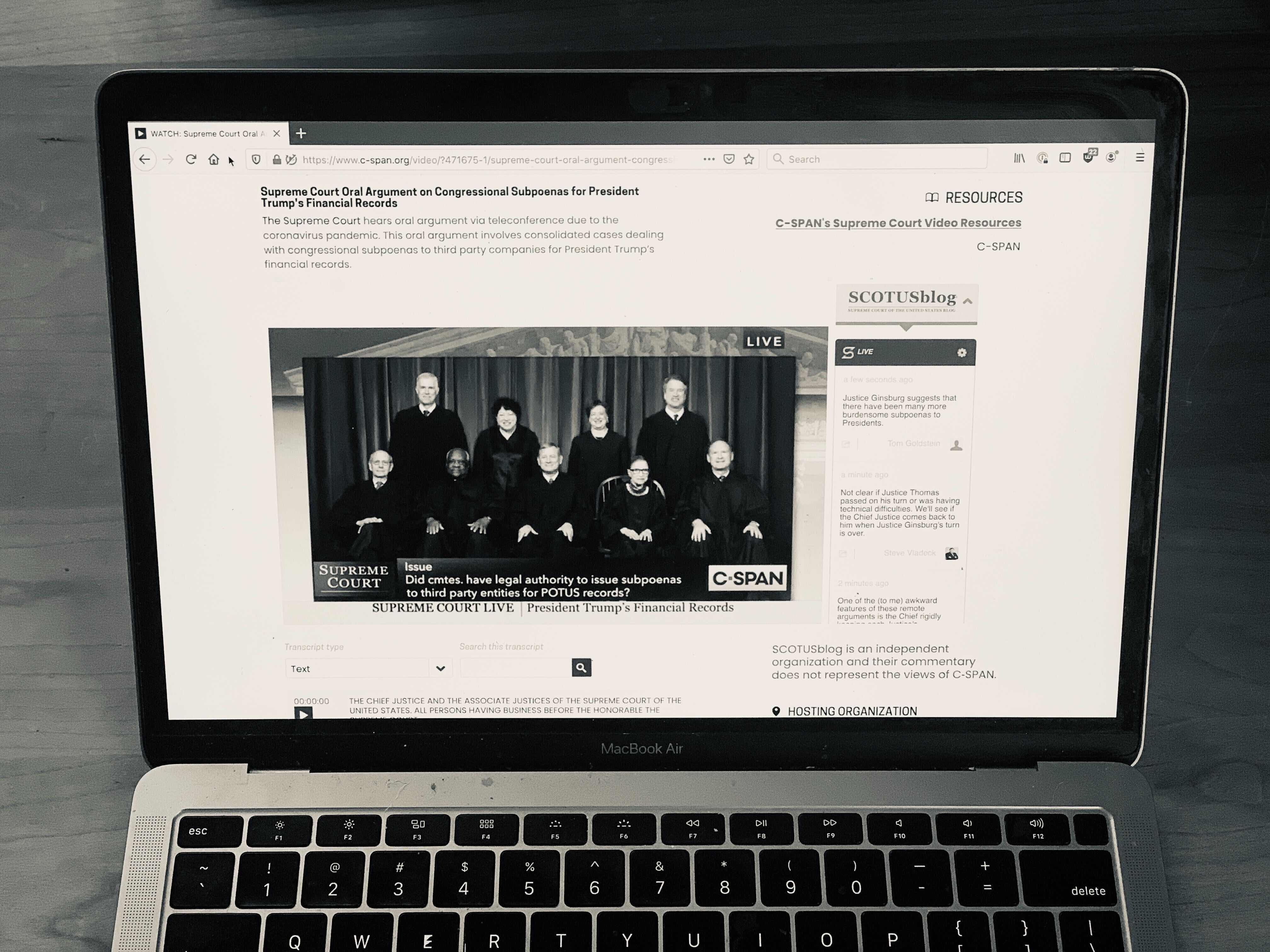The Supreme Court Rules in the Trump Subpoena Cases
In the end, President Trump has probably succeeded in his effort to keep his financial records from Congress through the November election. But if his goal was to prevent the judiciary from enforcing congressional subpoenas affecting him, he has likely failed.

Published by The Lawfare Institute
in Cooperation With

President Trump went to the Supreme Court asking the justices to protect him from subpoenas for his financial records—subpoenas from congressional committees and subpoenas from a New York state grand jury. He didn’t get the shield against accountability that he sought. In the New York case, he lost decisively. In his higher-profile battle with Congress, the court sought a middle ground, and it found one on a broad 7-to-2 vote.
Who precisely gets to claim this middle ground as victory remains to be seen. The court was by no means heedless of President Trump’s expressed concerns about congressional harassment of a president. Indeed, the justices showed a notable sensitivity to the separation of powers issues that might arise when Congress seeks personal papers from a president. But the court also rejected key presidential arguments, and it left a lot of room for Congress to prevail in litigation that will now follow. The court here attempted a solomonic effort to split a baby—leaving it to later litigation to determine whether the executive branch or the legislature got the bigger half.
In the end, Trump has probably succeeded in his short-term effort to keep his financial records from Congress through the November election. But if his goal was to prevent the judiciary from enforcing congressional subpoenas affecting him, he has likely failed. And if his goal was a longer-term effort to denude Congress of the power to investigate the president, he has likely failed at that too.
The simpler of the two cases decided today was the New York grand jury case, Trump v. Vance. A New York grand jury subpoenaed from Trump’s accounting firm Mazars USA, LLP for what the Supreme Court described “financial records relating to the President and business organizations affiliated with him, including ‘[t]ax returns and related schedules,’ from ‘2011 to the present.’” Trump sued to stop the subpoena, arguing that the president was categorically immune from state criminal process.
This argument did not detain the Supreme Court all that much. All nine justices, by somewhat different means, rejected the claim of absolute immunity. In an opinion for five justices, Chief Justice John Roberts noted the long history of presidents complying with federal subpoenas in criminal matters, and contended that state court subpoenas are not all that different. He rejected as well the contention that some kind of heightened showing of need is appropriate where the president is the subject of a subpoena. And the majority remanded the case for whatever further proceedings may be necessary.
Two additional justices—Brett Kavanaugh and Neil Gorsuch—concurred in the judgment but would have applied a heightened need test for state subpoenas for presidential material. And two more justices—Samuel Alito and Clarence Thomas—while also rejecting the claimed absolute immunity, both dissent on theories that the court owed the president more solicitude than it showed.
So the end result is a pretty complete defeat for the president: a unanimous rejection of his absolute immunity claim combined with a solid majority rejecting his claim for a heightened showing of need to enforce a state subpoena.
The second case, Trump v. Mazars, featured the same 7-2 voting pattern, with Thomas and Alito dissenting again. But both the case itself and the decision are more complex than Vance. Whereas Vance concerned an effort by New York state law enforcement to obtain financial records linked to the president, Mazars involved a similar effort by various House committees seeking documents from, variously, Deutsche Bank, Capital One and Trump’s accounting firm. As in Vance, the committees subpoenaed the entities for an array of materials; as in Vance, Trump sued to block the subpoenas. Here, Trump asserted that separation of powers concerns required that Congress display a “demonstrated, specific need”—quoting U.S. v. Nixon—in order to subpoena the records. The committees had failed to show that need, Trump argued, and lacked the “legitimate legislative purpose” necessary to justify the subpoenas.
Here, too, Chief Justice Roberts pushed back against the president’s more aggressive arguments. The majority rejected the comparison to Nixon, pointing out that the records at issue in Mazars, unlike in Nixon, did not implicate executive privilege. Taking the “categorical approach” of applying Nixon to all congressional subpoenas for presidential information would, wrote Roberts, give “short shrift to Congress’s important interests in conducting inquiries to obtain the information it needs to legislate effectively.”
But the majority also rejected the approach recommended by Congress, describing it as essentially limitless. According to the court, the committees’ assertion of broad investigative powers failed to recognize the separation of powers concerns that arise when a committee issues a subpoena for a president’s information. Even when a subpoena seeks a president’s personal papers, even when that subpoena is issued to a third party, and even when the president sues in his personal capacity, the subpoena creates an interbranch conflict of which courts must be mindful. In the view of the majority, the lower courts gave too little attention to this issue.
Mazars presented unprecedented issues for the court, which has never before addressed a congressional subpoena for the president’s personal information. The majority noted the crucial difference between this case and Vance: the president’s information is sought by committees of Congress, and Congress and the president have an “ongoing relationship that the Framers intended to feature both rivalry and reciprocity.”
To thread the needle between Trump’s claims and those of the committees, the majority outlined four special considerations to help courts balance Congress’s significant legislative interests against the “unique position” of the president. First, the majority stated that courts should assess Congress’s need for the information at issue: When Congress can reasonably obtain the information from other sources, it may not seek the information from the president. Second, courts should only permit subpoenas that are “no broader than reasonably necessary” to support Congress’s legislative objective. Third, courts should pay close attention to Congress’s assertions that a subpoena advances a valid legislative purpose, particularly when that legislative purpose raises constitutional questions (as legislation concerning the presidency does). Where the evidence that a subpoena advances a valid legislative purpose is more detailed and more substantial, the subpoena is more likely to be permissible. Fourth, noting Congress’s incentive to use subpoenas for “institutional advantage,” the majority instructs courts to inquire into the burdens that a subpoena would impose on the president. Though the opinion specifically set out only four considerations, it also recognized that other considerations “may be pertinent” as well. The court did not identify a specific test for lower courts to use, but in light of these instructions, it remanded the case to the U.S. Courts of Appeals for the D.C. Circuit and the Second Circuit for further proceedings.
In neither case is the Supreme Court’s ruling the final story. In the Vance opinion, Roberts writes that Trump can still “raise subpoena-specific constitutional challenges” in state and federal court. And the president’s attorney, Jay Sekulow, indicated he plans to do exactly that, issuing a statement that “the Supreme Court has temporarily blocked both Congress and New York prosecutors from obtaining the president’s tax records” and pledging to “proceed to raise additional constitutional and legal issues in the lower courts.”
The president will now likely amend the complaint seeking an injunction at the district court to raise subpoena-specific arguments before any records are turned over. Trump’s lawyers have been relatively clear that if their immunity argument failed, Plan B was to delay. In the March reply brief, they argued that if he lost, the president should still have “the opportunity to develop a factual record. There was no chance to do so below, any findings the district court made have been vacated, and the President is entitled to adduce evidence on heightened need, bad faith, and interference with official duties.”
For the subpoenas at issue in Mazars, the route forward is even less clear. The Supreme Court vacated both decisions on appeal and remanded the matters back to the courts of appeal for further consideration of the separation of powers issues they implicate, with specific reference to the factors identified by the majority. Earlier opinions by appeals courts concerning the subpoenas largely sidestepped most of the separation of powers concerns now raised by the Supreme Court on the grounds that the subpoenas had been issued to private third parties, and they instead focused on the relationship between the requests and a valid legislative purpose. Both courts are almost certain to require new rounds of argument before issuing revised opinions along the lines directed by the Supreme Court. They may even have to remand further to the district courts for additional testimony and evidence if the existing factual records prove inadequate to address the Court’s concerns, though it’s unclear whether this step will be necessary.
Either way, the courts are unlikely to require Trump to comply with the subpoenas before the November elections. And that is certainly a victory for a president who has endeavored tenaciously to keep his financial records secret.
But the fact that Trump may have won this most immediate battle does not mean he has won—or will win—the war. The majority closes its opinion with the admonition that “it ‘unquestionably’ remains ‘the duty of all citizens to cooperate” with Congress when the legislature “seeks information ‘needed for intelligent legislative action’”—underscoring the fact that, in the Supreme Court’s view, a properly balanced, tailored, and justified subpoena for a president’s private information can, in fact, be enforced by the courts. The Supreme Court decision gives congressional subpoenas a roadmap for crafting subpoenas for private presidential papers that will pass muster. So even if the current ones do not make the cut, the president may yet be forced to acquiesce to the disclosure of his financial records if Trump wins reelection and the next Congress decides to reissue similar subpoenas. What’s more, if he loses reelection, then the separation of powers concerns at the crux of his arguments against disclosure largely go away, making eventual disclosure even more likely if Congress continues pursuing his records.
It’s not yet clear how the appellate courts will apply the Mazars factors to the existing subpoenas, or what other factors it may deem relevant to their enforceability. Not all of the congressional subpoenas are created equal with respect to the court’s four factors. The House Intelligence Committee subpoena and at least part of the Oversight subpoena request information in relation to legislation that is specifically relevant to the president and his financial conduct; these seem like plausible candidates for surviving further scrutiny—especially if the relevant committees prove willing to tailor them and supplement the record to better comply with the Mazars factors. The Financial Services Committee subpoena, by contrast, may be more of a stretch, as the committee has primarily justified it in relation to broader legislation regarding international financial transactions and global real estate markets not specifically related to the president. Perhaps it too can be adapted, but it seems likely to run afoul of the Supreme Court’s warning that a presidential subpoena cannot be used to generate what is merely a “case study” of a more generic public policy problem. While there are no guarantees, ultimately refusing to enforce a properly tailored subpoena will be far harder for the court to do after today’s opinion. And if it recognizes this, then the president’s counsel may urge him to reach some sort of compromise with the House to avoid the risk of an adverse ruling--precisely the sort of accommodation that the majority seems to prefer for resolving these sorts of separation of powers disputes.
So who won? As Dahlia Lithwick wryly put it on the “In Lieu of Fun” show the afternoon of the Supreme Court’s ruling, everyone’s a winner today, albeit not all of them in the ways they would have wanted. The president almost certainly pushed the matter beyond the election. The Manhattan district attorney won a clear ruling that the president is not categorically immune from state criminal process. The executive branch won a certain special solicitude from the courts in considering subpoenas for personal presidential papers. Congress found itself saddled with more constraints on its investigatory authority than it previously enjoyed, but it won the important precedent—including from three conservative justices, two of them appointed by President Trump himself—that if it dots its i’s and crosses its t’s, it’s entitled to have its subpoenas respected, even by the president. And the court itself, and Roberts in particular, won a non-ideological resolution of a divisive partisan issue in the midst of an election year.
Nobody, except perhaps Roberts himself, is likely to be thrilled with the Mazars opinion. But it threaded a needle with a tiny eye-hole more gracefully than many analysts imagined the justices could. And it is just barely possible, if not very likely, that it will induce precisely the negotiation process that the court’s opinion complains did not take place.
Correction: An earlier version of this article misstated the appeals courts to which the Supreme Court remanded the Mazars case.







.jpg?sfvrsn=5a43131e_9)

